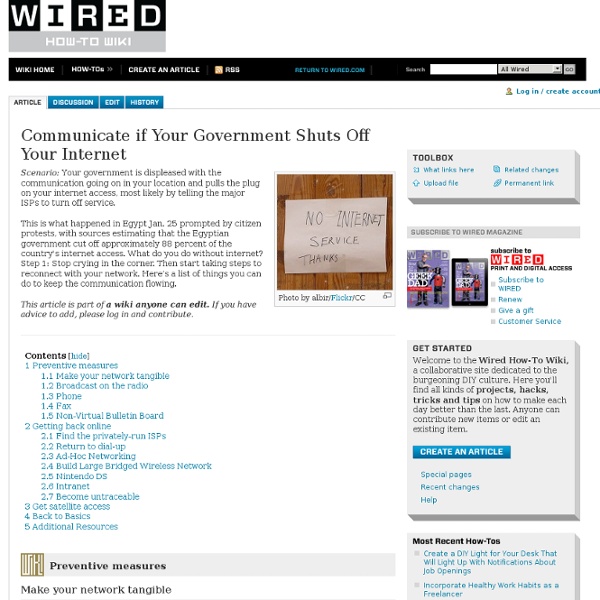How-to wiki

Anonymous Surfing & Free Proxy List
Available proxy servers stats Proxy servers for registered members:15191 Free sample proxy servers:140 Proxy list will be updated in:57 seconds Local server time:00:19:27 UTC 140 free sample proxy servers Download proxy list as txt, csv or xml You can download proxy list with personal download link.
Around blocking
How to install the Circumventor program, which gets around all Web-blocking software Bennett Haselton This page describes how to install the "Circumventor" program, which can be used to get around all Web blocking programs. However, Please Note!! You don't actually install the Circumventor on the computer that is blocked from accessing Web sites. You, or a friend of yours, has to install the Circumventor on some other machine which is not censored. For example, if you want to get around Web blocking at work, don't install the Circumventor on your work computer. If you want to, please enter your email address below if you would like to receive updates about the Circumventor software. How to install the Circumventor The machine where you install the Circumventor must have a fast Internet connection (not dial-up), and it must be running Windows XP or 2000 (this includes most computers these days). To install: Download ActivePerl from this link and install it. Happy surfing! Special thanks
How-To Bypass Egypt Block for Facebook & Twitter « Texnomic
I've Created a FREE VPN Server for ALL Egyptians to bypass Internet Blockage in Egypt and to "Empower The Revolution" of #Jan25 This (Virtual Private Network) VPN Connect creates an Unblockable and Secure Connection to our Server in USA to bypass ALL Internet Blockage in Egypt (Example: Facebook, Twitter and Dostor). Special Thanks for the team members: @Wael_Aziz and @Sherif_ and @Hend_Hafez Announcements: Update 1: Egypt Revolution 2.0 Completed Successfully. Update 2: Egypt Revolution 2.0 Completed Successfully.
Related:
Related:



